Impact of Leadership and Multicultural Teams in International Business
VerifiedAdded on 2023/01/20
|8
|2213
|66
Report
AI Summary
This report delves into the intricacies of international business management, emphasizing the critical roles of leadership and team dynamics. The author explores various leadership styles, with a focus on cross-cultural leadership, and provides a personal account of how this approach transformed a multinational company's operations. The report highlights the challenges of multicultural team management, including communication barriers and the importance of understanding diverse cultural perspectives. It discusses strategies for effective team leadership, such as fostering open communication, respecting individual differences, and building team cohesion through activities beyond work. The report concludes by underscoring the significance of adaptable leadership and team management in navigating the complexities of international business, advocating for understanding, accommodation, and adaptation as key principles for success. The author also includes references to support the findings and recommendations presented in the report.
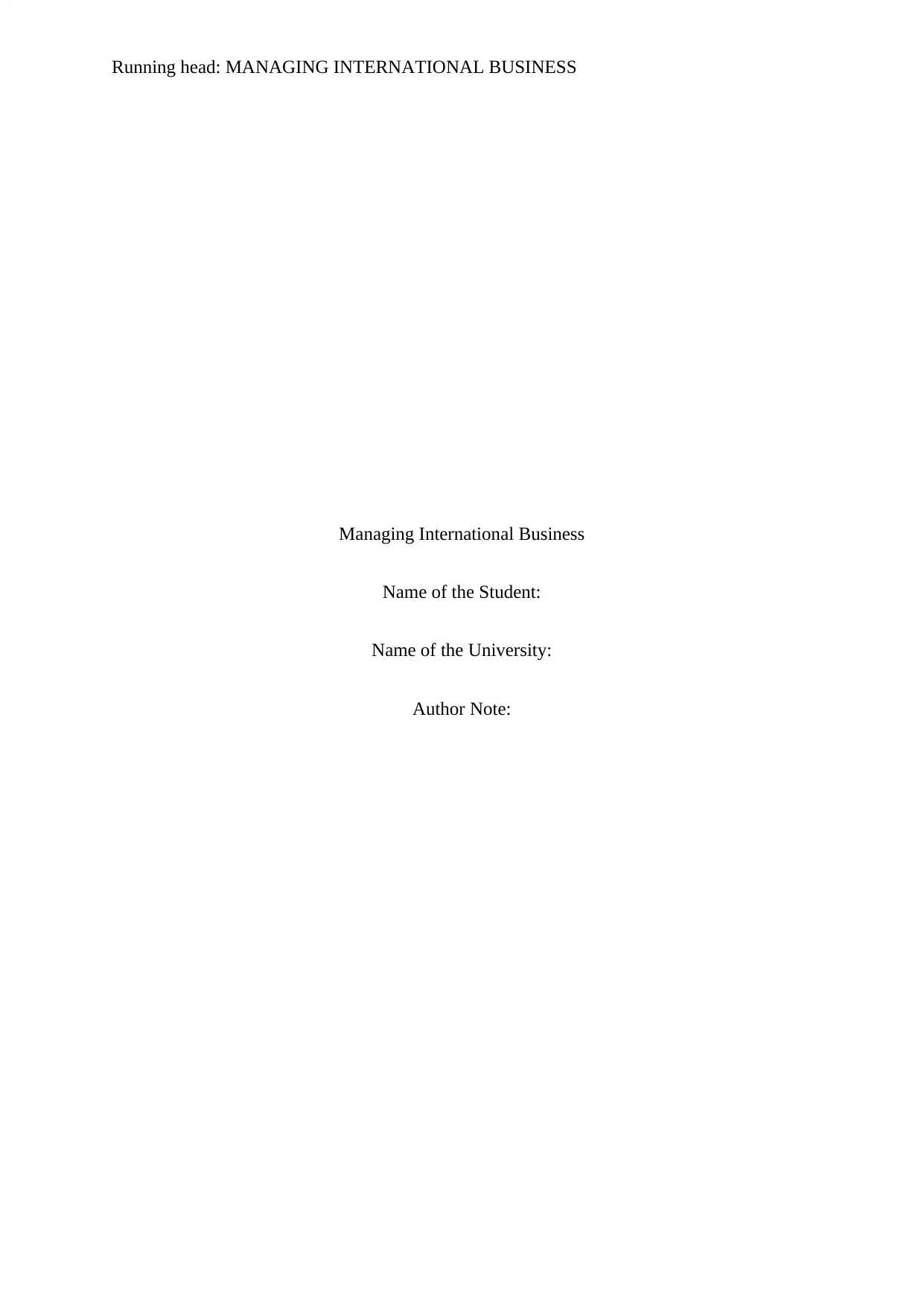
Running head: MANAGING INTERNATIONAL BUSINESS
Managing International Business
Name of the Student:
Name of the University:
Author Note:
Managing International Business
Name of the Student:
Name of the University:
Author Note:
Paraphrase This Document
Need a fresh take? Get an instant paraphrase of this document with our AI Paraphraser
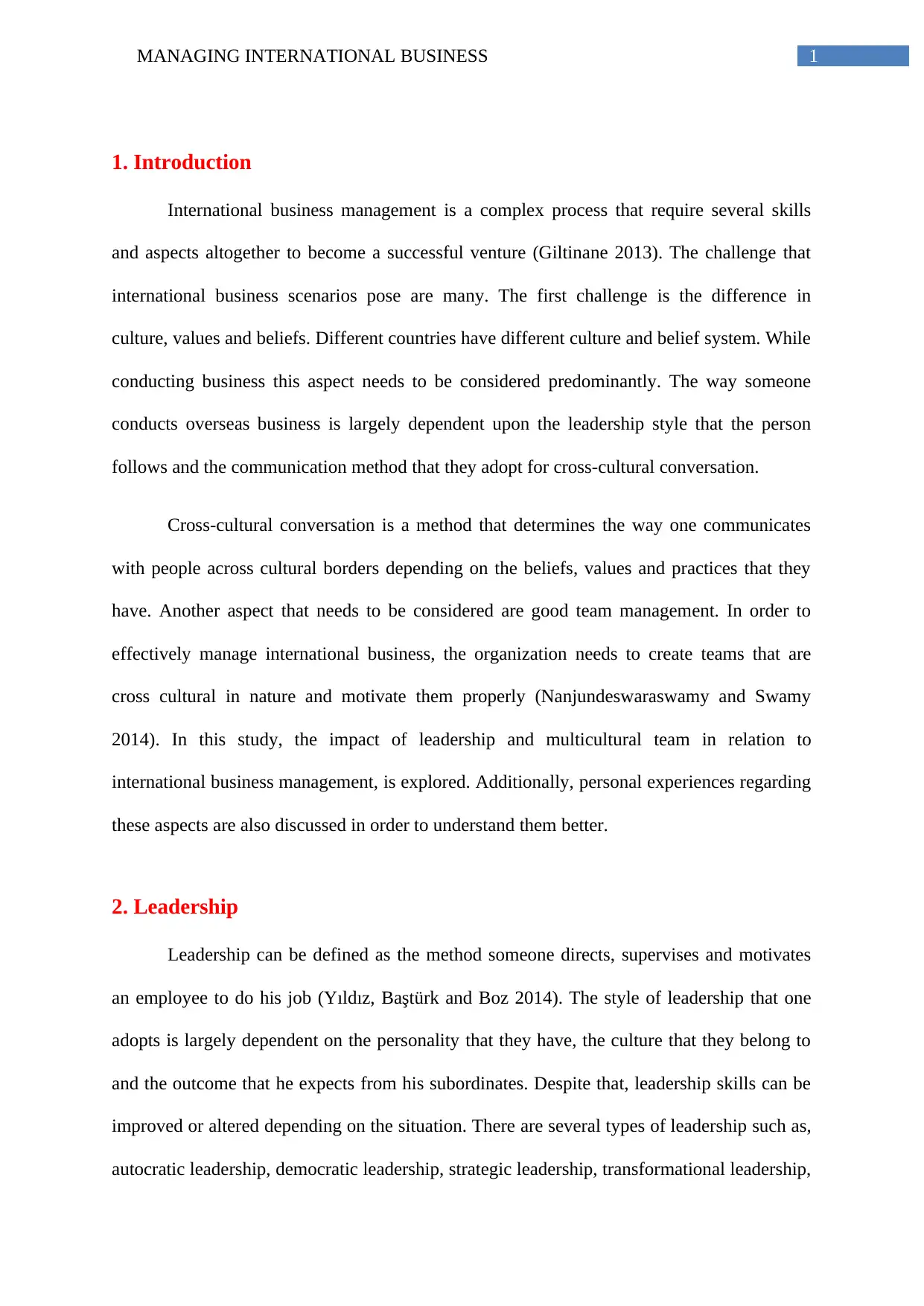
1MANAGING INTERNATIONAL BUSINESS
1. Introduction
International business management is a complex process that require several skills
and aspects altogether to become a successful venture (Giltinane 2013). The challenge that
international business scenarios pose are many. The first challenge is the difference in
culture, values and beliefs. Different countries have different culture and belief system. While
conducting business this aspect needs to be considered predominantly. The way someone
conducts overseas business is largely dependent upon the leadership style that the person
follows and the communication method that they adopt for cross-cultural conversation.
Cross-cultural conversation is a method that determines the way one communicates
with people across cultural borders depending on the beliefs, values and practices that they
have. Another aspect that needs to be considered are good team management. In order to
effectively manage international business, the organization needs to create teams that are
cross cultural in nature and motivate them properly (Nanjundeswaraswamy and Swamy
2014). In this study, the impact of leadership and multicultural team in relation to
international business management, is explored. Additionally, personal experiences regarding
these aspects are also discussed in order to understand them better.
2. Leadership
Leadership can be defined as the method someone directs, supervises and motivates
an employee to do his job (Yıldız, Baştürk and Boz 2014). The style of leadership that one
adopts is largely dependent on the personality that they have, the culture that they belong to
and the outcome that he expects from his subordinates. Despite that, leadership skills can be
improved or altered depending on the situation. There are several types of leadership such as,
autocratic leadership, democratic leadership, strategic leadership, transformational leadership,
1. Introduction
International business management is a complex process that require several skills
and aspects altogether to become a successful venture (Giltinane 2013). The challenge that
international business scenarios pose are many. The first challenge is the difference in
culture, values and beliefs. Different countries have different culture and belief system. While
conducting business this aspect needs to be considered predominantly. The way someone
conducts overseas business is largely dependent upon the leadership style that the person
follows and the communication method that they adopt for cross-cultural conversation.
Cross-cultural conversation is a method that determines the way one communicates
with people across cultural borders depending on the beliefs, values and practices that they
have. Another aspect that needs to be considered are good team management. In order to
effectively manage international business, the organization needs to create teams that are
cross cultural in nature and motivate them properly (Nanjundeswaraswamy and Swamy
2014). In this study, the impact of leadership and multicultural team in relation to
international business management, is explored. Additionally, personal experiences regarding
these aspects are also discussed in order to understand them better.
2. Leadership
Leadership can be defined as the method someone directs, supervises and motivates
an employee to do his job (Yıldız, Baştürk and Boz 2014). The style of leadership that one
adopts is largely dependent on the personality that they have, the culture that they belong to
and the outcome that he expects from his subordinates. Despite that, leadership skills can be
improved or altered depending on the situation. There are several types of leadership such as,
autocratic leadership, democratic leadership, strategic leadership, transformational leadership,
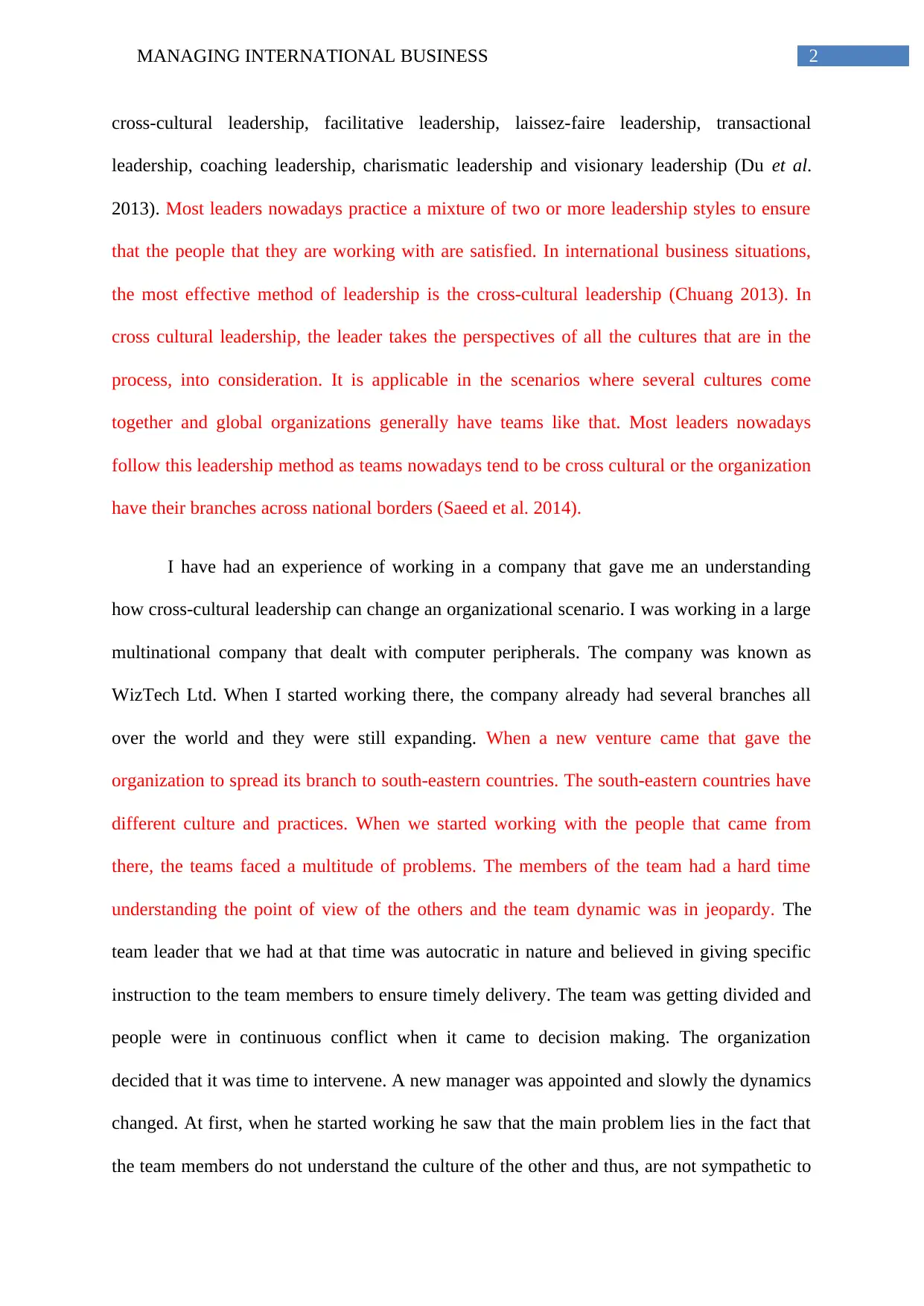
2MANAGING INTERNATIONAL BUSINESS
cross-cultural leadership, facilitative leadership, laissez-faire leadership, transactional
leadership, coaching leadership, charismatic leadership and visionary leadership (Du et al.
2013). Most leaders nowadays practice a mixture of two or more leadership styles to ensure
that the people that they are working with are satisfied. In international business situations,
the most effective method of leadership is the cross-cultural leadership (Chuang 2013). In
cross cultural leadership, the leader takes the perspectives of all the cultures that are in the
process, into consideration. It is applicable in the scenarios where several cultures come
together and global organizations generally have teams like that. Most leaders nowadays
follow this leadership method as teams nowadays tend to be cross cultural or the organization
have their branches across national borders (Saeed et al. 2014).
I have had an experience of working in a company that gave me an understanding
how cross-cultural leadership can change an organizational scenario. I was working in a large
multinational company that dealt with computer peripherals. The company was known as
WizTech Ltd. When I started working there, the company already had several branches all
over the world and they were still expanding. When a new venture came that gave the
organization to spread its branch to south-eastern countries. The south-eastern countries have
different culture and practices. When we started working with the people that came from
there, the teams faced a multitude of problems. The members of the team had a hard time
understanding the point of view of the others and the team dynamic was in jeopardy. The
team leader that we had at that time was autocratic in nature and believed in giving specific
instruction to the team members to ensure timely delivery. The team was getting divided and
people were in continuous conflict when it came to decision making. The organization
decided that it was time to intervene. A new manager was appointed and slowly the dynamics
changed. At first, when he started working he saw that the main problem lies in the fact that
the team members do not understand the culture of the other and thus, are not sympathetic to
cross-cultural leadership, facilitative leadership, laissez-faire leadership, transactional
leadership, coaching leadership, charismatic leadership and visionary leadership (Du et al.
2013). Most leaders nowadays practice a mixture of two or more leadership styles to ensure
that the people that they are working with are satisfied. In international business situations,
the most effective method of leadership is the cross-cultural leadership (Chuang 2013). In
cross cultural leadership, the leader takes the perspectives of all the cultures that are in the
process, into consideration. It is applicable in the scenarios where several cultures come
together and global organizations generally have teams like that. Most leaders nowadays
follow this leadership method as teams nowadays tend to be cross cultural or the organization
have their branches across national borders (Saeed et al. 2014).
I have had an experience of working in a company that gave me an understanding
how cross-cultural leadership can change an organizational scenario. I was working in a large
multinational company that dealt with computer peripherals. The company was known as
WizTech Ltd. When I started working there, the company already had several branches all
over the world and they were still expanding. When a new venture came that gave the
organization to spread its branch to south-eastern countries. The south-eastern countries have
different culture and practices. When we started working with the people that came from
there, the teams faced a multitude of problems. The members of the team had a hard time
understanding the point of view of the others and the team dynamic was in jeopardy. The
team leader that we had at that time was autocratic in nature and believed in giving specific
instruction to the team members to ensure timely delivery. The team was getting divided and
people were in continuous conflict when it came to decision making. The organization
decided that it was time to intervene. A new manager was appointed and slowly the dynamics
changed. At first, when he started working he saw that the main problem lies in the fact that
the team members do not understand the culture of the other and thus, are not sympathetic to
⊘ This is a preview!⊘
Do you want full access?
Subscribe today to unlock all pages.

Trusted by 1+ million students worldwide
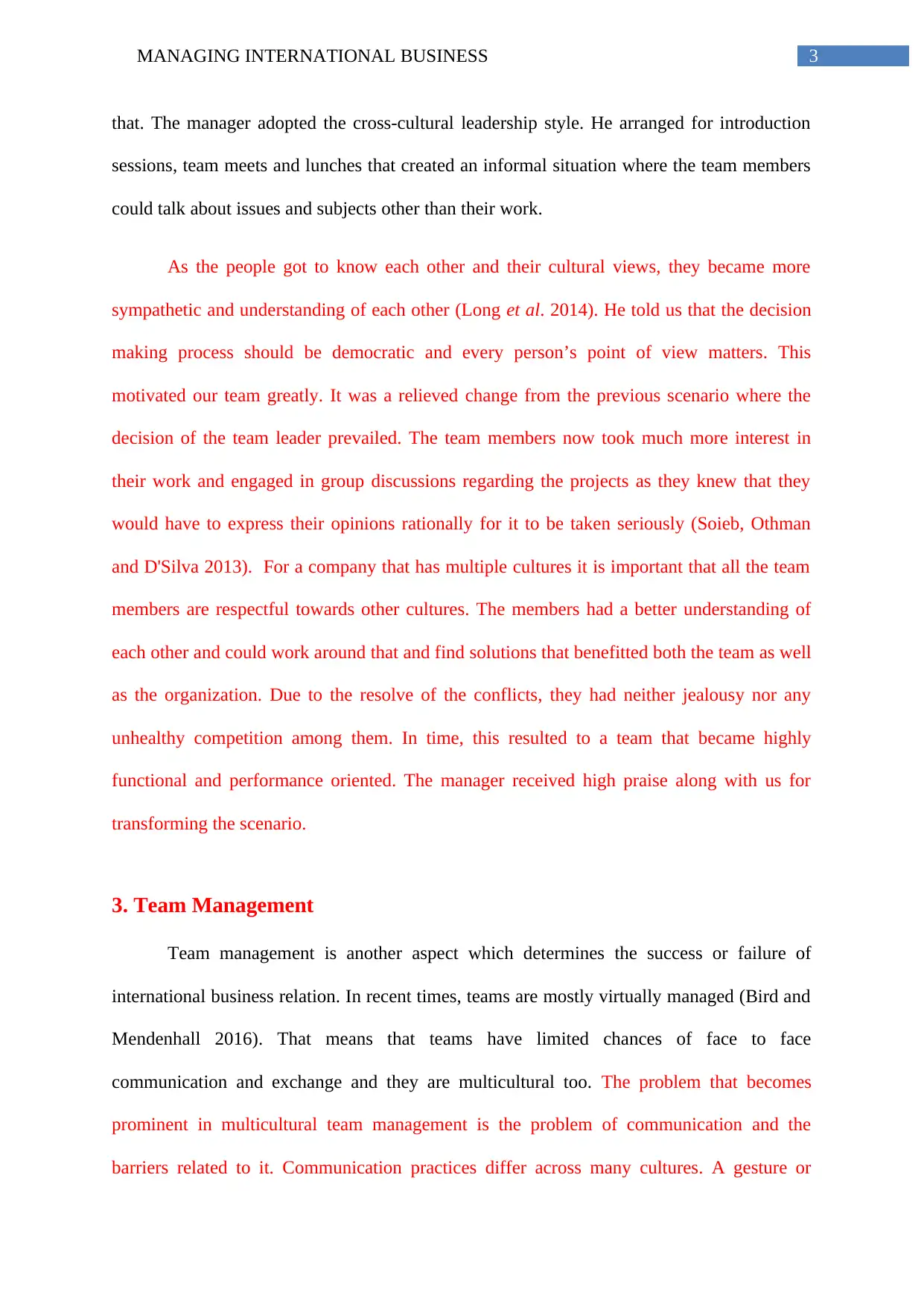
3MANAGING INTERNATIONAL BUSINESS
that. The manager adopted the cross-cultural leadership style. He arranged for introduction
sessions, team meets and lunches that created an informal situation where the team members
could talk about issues and subjects other than their work.
As the people got to know each other and their cultural views, they became more
sympathetic and understanding of each other (Long et al. 2014). He told us that the decision
making process should be democratic and every person’s point of view matters. This
motivated our team greatly. It was a relieved change from the previous scenario where the
decision of the team leader prevailed. The team members now took much more interest in
their work and engaged in group discussions regarding the projects as they knew that they
would have to express their opinions rationally for it to be taken seriously (Soieb, Othman
and D'Silva 2013). For a company that has multiple cultures it is important that all the team
members are respectful towards other cultures. The members had a better understanding of
each other and could work around that and find solutions that benefitted both the team as well
as the organization. Due to the resolve of the conflicts, they had neither jealousy nor any
unhealthy competition among them. In time, this resulted to a team that became highly
functional and performance oriented. The manager received high praise along with us for
transforming the scenario.
3. Team Management
Team management is another aspect which determines the success or failure of
international business relation. In recent times, teams are mostly virtually managed (Bird and
Mendenhall 2016). That means that teams have limited chances of face to face
communication and exchange and they are multicultural too. The problem that becomes
prominent in multicultural team management is the problem of communication and the
barriers related to it. Communication practices differ across many cultures. A gesture or
that. The manager adopted the cross-cultural leadership style. He arranged for introduction
sessions, team meets and lunches that created an informal situation where the team members
could talk about issues and subjects other than their work.
As the people got to know each other and their cultural views, they became more
sympathetic and understanding of each other (Long et al. 2014). He told us that the decision
making process should be democratic and every person’s point of view matters. This
motivated our team greatly. It was a relieved change from the previous scenario where the
decision of the team leader prevailed. The team members now took much more interest in
their work and engaged in group discussions regarding the projects as they knew that they
would have to express their opinions rationally for it to be taken seriously (Soieb, Othman
and D'Silva 2013). For a company that has multiple cultures it is important that all the team
members are respectful towards other cultures. The members had a better understanding of
each other and could work around that and find solutions that benefitted both the team as well
as the organization. Due to the resolve of the conflicts, they had neither jealousy nor any
unhealthy competition among them. In time, this resulted to a team that became highly
functional and performance oriented. The manager received high praise along with us for
transforming the scenario.
3. Team Management
Team management is another aspect which determines the success or failure of
international business relation. In recent times, teams are mostly virtually managed (Bird and
Mendenhall 2016). That means that teams have limited chances of face to face
communication and exchange and they are multicultural too. The problem that becomes
prominent in multicultural team management is the problem of communication and the
barriers related to it. Communication practices differ across many cultures. A gesture or
Paraphrase This Document
Need a fresh take? Get an instant paraphrase of this document with our AI Paraphraser
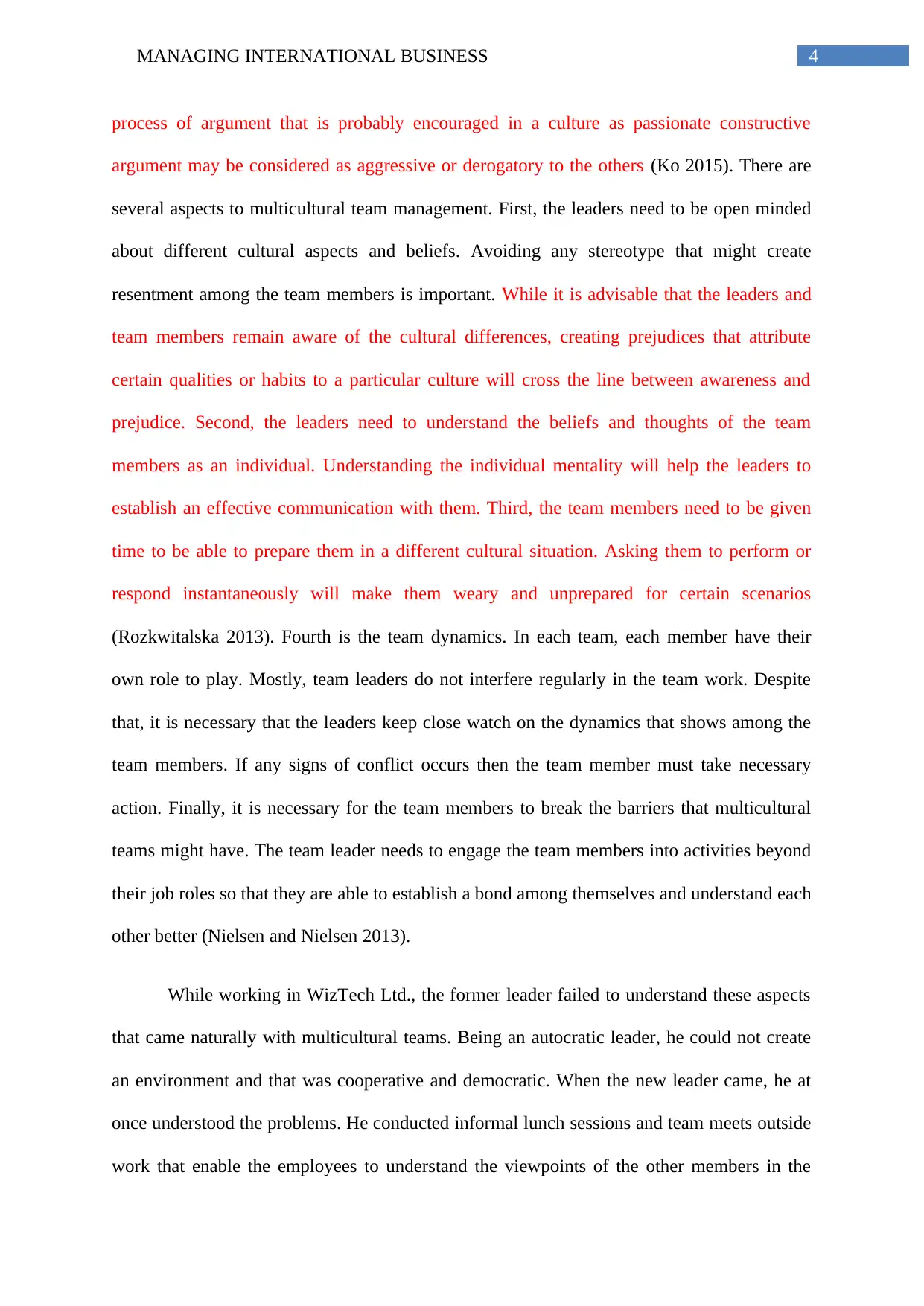
4MANAGING INTERNATIONAL BUSINESS
process of argument that is probably encouraged in a culture as passionate constructive
argument may be considered as aggressive or derogatory to the others (Ko 2015). There are
several aspects to multicultural team management. First, the leaders need to be open minded
about different cultural aspects and beliefs. Avoiding any stereotype that might create
resentment among the team members is important. While it is advisable that the leaders and
team members remain aware of the cultural differences, creating prejudices that attribute
certain qualities or habits to a particular culture will cross the line between awareness and
prejudice. Second, the leaders need to understand the beliefs and thoughts of the team
members as an individual. Understanding the individual mentality will help the leaders to
establish an effective communication with them. Third, the team members need to be given
time to be able to prepare them in a different cultural situation. Asking them to perform or
respond instantaneously will make them weary and unprepared for certain scenarios
(Rozkwitalska 2013). Fourth is the team dynamics. In each team, each member have their
own role to play. Mostly, team leaders do not interfere regularly in the team work. Despite
that, it is necessary that the leaders keep close watch on the dynamics that shows among the
team members. If any signs of conflict occurs then the team member must take necessary
action. Finally, it is necessary for the team members to break the barriers that multicultural
teams might have. The team leader needs to engage the team members into activities beyond
their job roles so that they are able to establish a bond among themselves and understand each
other better (Nielsen and Nielsen 2013).
While working in WizTech Ltd., the former leader failed to understand these aspects
that came naturally with multicultural teams. Being an autocratic leader, he could not create
an environment and that was cooperative and democratic. When the new leader came, he at
once understood the problems. He conducted informal lunch sessions and team meets outside
work that enable the employees to understand the viewpoints of the other members in the
process of argument that is probably encouraged in a culture as passionate constructive
argument may be considered as aggressive or derogatory to the others (Ko 2015). There are
several aspects to multicultural team management. First, the leaders need to be open minded
about different cultural aspects and beliefs. Avoiding any stereotype that might create
resentment among the team members is important. While it is advisable that the leaders and
team members remain aware of the cultural differences, creating prejudices that attribute
certain qualities or habits to a particular culture will cross the line between awareness and
prejudice. Second, the leaders need to understand the beliefs and thoughts of the team
members as an individual. Understanding the individual mentality will help the leaders to
establish an effective communication with them. Third, the team members need to be given
time to be able to prepare them in a different cultural situation. Asking them to perform or
respond instantaneously will make them weary and unprepared for certain scenarios
(Rozkwitalska 2013). Fourth is the team dynamics. In each team, each member have their
own role to play. Mostly, team leaders do not interfere regularly in the team work. Despite
that, it is necessary that the leaders keep close watch on the dynamics that shows among the
team members. If any signs of conflict occurs then the team member must take necessary
action. Finally, it is necessary for the team members to break the barriers that multicultural
teams might have. The team leader needs to engage the team members into activities beyond
their job roles so that they are able to establish a bond among themselves and understand each
other better (Nielsen and Nielsen 2013).
While working in WizTech Ltd., the former leader failed to understand these aspects
that came naturally with multicultural teams. Being an autocratic leader, he could not create
an environment and that was cooperative and democratic. When the new leader came, he at
once understood the problems. He conducted informal lunch sessions and team meets outside
work that enable the employees to understand the viewpoints of the other members in the
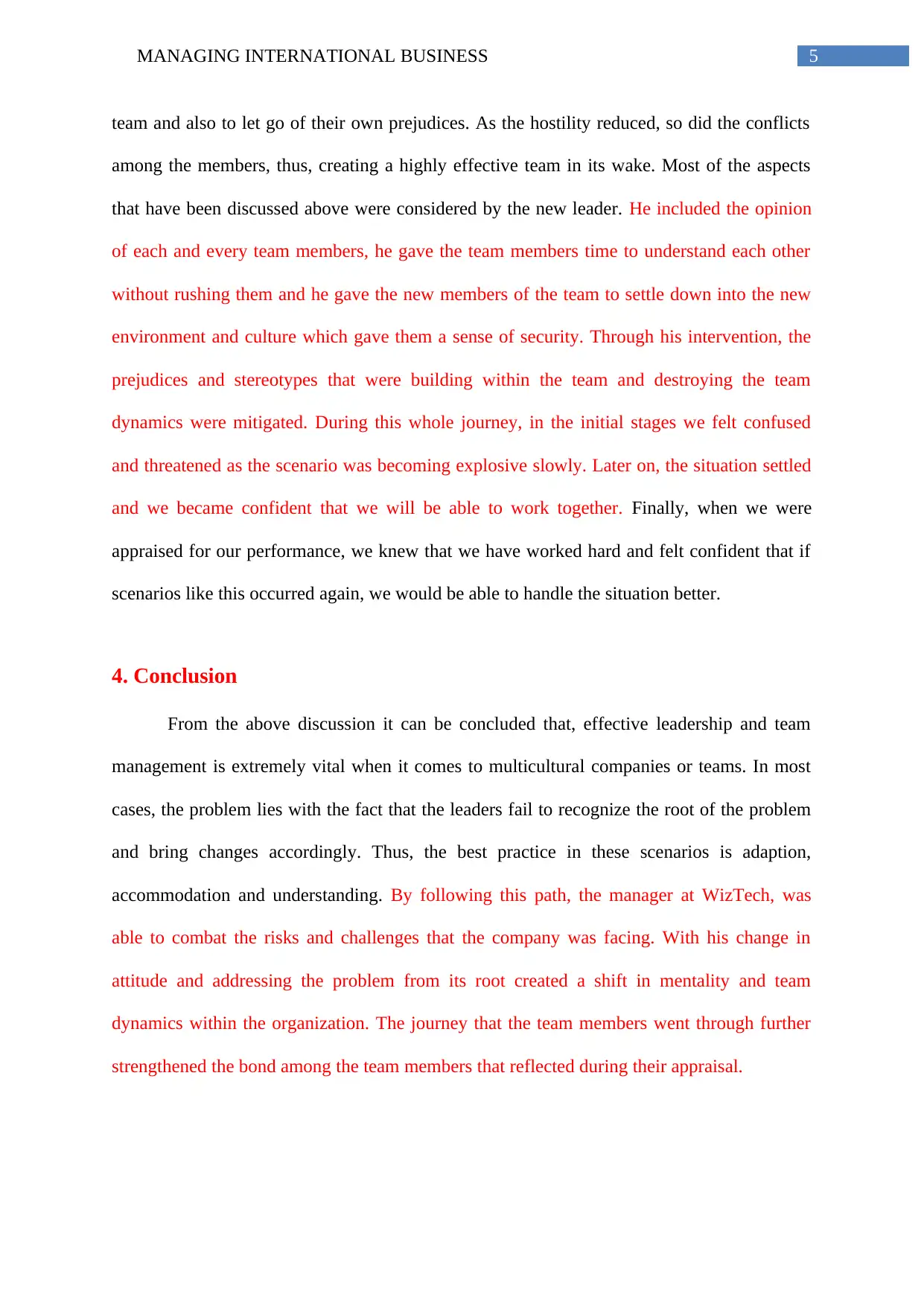
5MANAGING INTERNATIONAL BUSINESS
team and also to let go of their own prejudices. As the hostility reduced, so did the conflicts
among the members, thus, creating a highly effective team in its wake. Most of the aspects
that have been discussed above were considered by the new leader. He included the opinion
of each and every team members, he gave the team members time to understand each other
without rushing them and he gave the new members of the team to settle down into the new
environment and culture which gave them a sense of security. Through his intervention, the
prejudices and stereotypes that were building within the team and destroying the team
dynamics were mitigated. During this whole journey, in the initial stages we felt confused
and threatened as the scenario was becoming explosive slowly. Later on, the situation settled
and we became confident that we will be able to work together. Finally, when we were
appraised for our performance, we knew that we have worked hard and felt confident that if
scenarios like this occurred again, we would be able to handle the situation better.
4. Conclusion
From the above discussion it can be concluded that, effective leadership and team
management is extremely vital when it comes to multicultural companies or teams. In most
cases, the problem lies with the fact that the leaders fail to recognize the root of the problem
and bring changes accordingly. Thus, the best practice in these scenarios is adaption,
accommodation and understanding. By following this path, the manager at WizTech, was
able to combat the risks and challenges that the company was facing. With his change in
attitude and addressing the problem from its root created a shift in mentality and team
dynamics within the organization. The journey that the team members went through further
strengthened the bond among the team members that reflected during their appraisal.
team and also to let go of their own prejudices. As the hostility reduced, so did the conflicts
among the members, thus, creating a highly effective team in its wake. Most of the aspects
that have been discussed above were considered by the new leader. He included the opinion
of each and every team members, he gave the team members time to understand each other
without rushing them and he gave the new members of the team to settle down into the new
environment and culture which gave them a sense of security. Through his intervention, the
prejudices and stereotypes that were building within the team and destroying the team
dynamics were mitigated. During this whole journey, in the initial stages we felt confused
and threatened as the scenario was becoming explosive slowly. Later on, the situation settled
and we became confident that we will be able to work together. Finally, when we were
appraised for our performance, we knew that we have worked hard and felt confident that if
scenarios like this occurred again, we would be able to handle the situation better.
4. Conclusion
From the above discussion it can be concluded that, effective leadership and team
management is extremely vital when it comes to multicultural companies or teams. In most
cases, the problem lies with the fact that the leaders fail to recognize the root of the problem
and bring changes accordingly. Thus, the best practice in these scenarios is adaption,
accommodation and understanding. By following this path, the manager at WizTech, was
able to combat the risks and challenges that the company was facing. With his change in
attitude and addressing the problem from its root created a shift in mentality and team
dynamics within the organization. The journey that the team members went through further
strengthened the bond among the team members that reflected during their appraisal.
⊘ This is a preview!⊘
Do you want full access?
Subscribe today to unlock all pages.

Trusted by 1+ million students worldwide
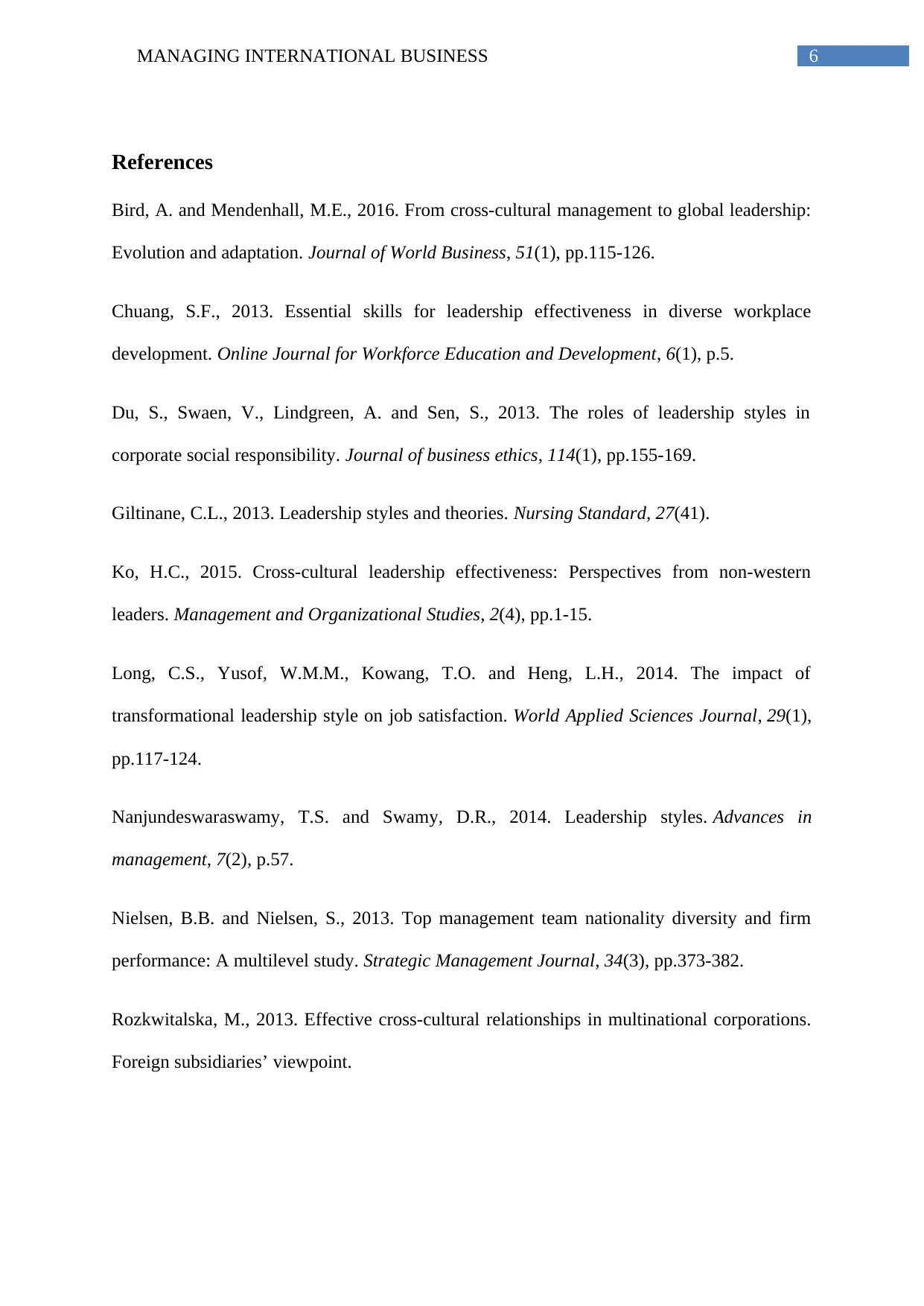
6MANAGING INTERNATIONAL BUSINESS
References
Bird, A. and Mendenhall, M.E., 2016. From cross-cultural management to global leadership:
Evolution and adaptation. Journal of World Business, 51(1), pp.115-126.
Chuang, S.F., 2013. Essential skills for leadership effectiveness in diverse workplace
development. Online Journal for Workforce Education and Development, 6(1), p.5.
Du, S., Swaen, V., Lindgreen, A. and Sen, S., 2013. The roles of leadership styles in
corporate social responsibility. Journal of business ethics, 114(1), pp.155-169.
Giltinane, C.L., 2013. Leadership styles and theories. Nursing Standard, 27(41).
Ko, H.C., 2015. Cross-cultural leadership effectiveness: Perspectives from non-western
leaders. Management and Organizational Studies, 2(4), pp.1-15.
Long, C.S., Yusof, W.M.M., Kowang, T.O. and Heng, L.H., 2014. The impact of
transformational leadership style on job satisfaction. World Applied Sciences Journal, 29(1),
pp.117-124.
Nanjundeswaraswamy, T.S. and Swamy, D.R., 2014. Leadership styles. Advances in
management, 7(2), p.57.
Nielsen, B.B. and Nielsen, S., 2013. Top management team nationality diversity and firm
performance: A multilevel study. Strategic Management Journal, 34(3), pp.373-382.
Rozkwitalska, M., 2013. Effective cross-cultural relationships in multinational corporations.
Foreign subsidiaries’ viewpoint.
References
Bird, A. and Mendenhall, M.E., 2016. From cross-cultural management to global leadership:
Evolution and adaptation. Journal of World Business, 51(1), pp.115-126.
Chuang, S.F., 2013. Essential skills for leadership effectiveness in diverse workplace
development. Online Journal for Workforce Education and Development, 6(1), p.5.
Du, S., Swaen, V., Lindgreen, A. and Sen, S., 2013. The roles of leadership styles in
corporate social responsibility. Journal of business ethics, 114(1), pp.155-169.
Giltinane, C.L., 2013. Leadership styles and theories. Nursing Standard, 27(41).
Ko, H.C., 2015. Cross-cultural leadership effectiveness: Perspectives from non-western
leaders. Management and Organizational Studies, 2(4), pp.1-15.
Long, C.S., Yusof, W.M.M., Kowang, T.O. and Heng, L.H., 2014. The impact of
transformational leadership style on job satisfaction. World Applied Sciences Journal, 29(1),
pp.117-124.
Nanjundeswaraswamy, T.S. and Swamy, D.R., 2014. Leadership styles. Advances in
management, 7(2), p.57.
Nielsen, B.B. and Nielsen, S., 2013. Top management team nationality diversity and firm
performance: A multilevel study. Strategic Management Journal, 34(3), pp.373-382.
Rozkwitalska, M., 2013. Effective cross-cultural relationships in multinational corporations.
Foreign subsidiaries’ viewpoint.
Paraphrase This Document
Need a fresh take? Get an instant paraphrase of this document with our AI Paraphraser
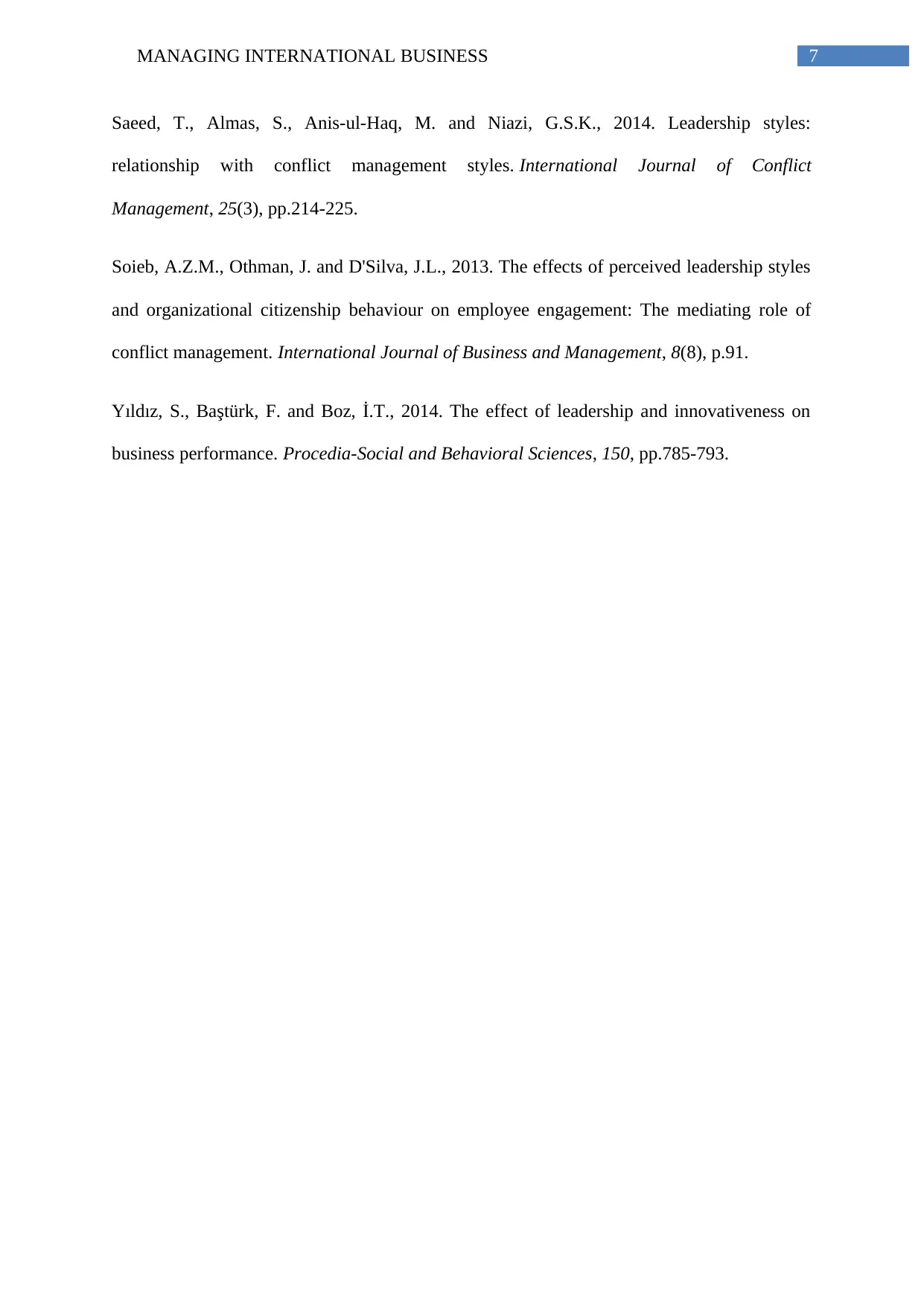
7MANAGING INTERNATIONAL BUSINESS
Saeed, T., Almas, S., Anis-ul-Haq, M. and Niazi, G.S.K., 2014. Leadership styles:
relationship with conflict management styles. International Journal of Conflict
Management, 25(3), pp.214-225.
Soieb, A.Z.M., Othman, J. and D'Silva, J.L., 2013. The effects of perceived leadership styles
and organizational citizenship behaviour on employee engagement: The mediating role of
conflict management. International Journal of Business and Management, 8(8), p.91.
Yıldız, S., Baştürk, F. and Boz, İ.T., 2014. The effect of leadership and innovativeness on
business performance. Procedia-Social and Behavioral Sciences, 150, pp.785-793.
Saeed, T., Almas, S., Anis-ul-Haq, M. and Niazi, G.S.K., 2014. Leadership styles:
relationship with conflict management styles. International Journal of Conflict
Management, 25(3), pp.214-225.
Soieb, A.Z.M., Othman, J. and D'Silva, J.L., 2013. The effects of perceived leadership styles
and organizational citizenship behaviour on employee engagement: The mediating role of
conflict management. International Journal of Business and Management, 8(8), p.91.
Yıldız, S., Baştürk, F. and Boz, İ.T., 2014. The effect of leadership and innovativeness on
business performance. Procedia-Social and Behavioral Sciences, 150, pp.785-793.
1 out of 8
Related Documents
Your All-in-One AI-Powered Toolkit for Academic Success.
+13062052269
info@desklib.com
Available 24*7 on WhatsApp / Email
![[object Object]](/_next/static/media/star-bottom.7253800d.svg)
Unlock your academic potential
Copyright © 2020–2025 A2Z Services. All Rights Reserved. Developed and managed by ZUCOL.




